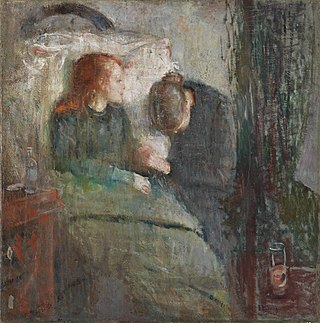The Sick Child (Munch)
In the works, Sophie is typically shown on her deathbed accompanied by a dark-haired, grieving woman assumed to be her aunt Karen; the studies often show her in a cropped head shot.
In all the painted versions Sophie is sitting in a chair, obviously suffering from pain, propped by a large white pillow, looking towards an ominous curtain likely intended as a symbol of death.
She is shown with a haunted expression, clutching hands with a grief-stricken older woman who seems to want to comfort her but whose head is bowed as if she cannot bear to look the younger girl in the eye.
[3] Each painting shows Sophie in profile, lying on her deathbed, and obviously having difficulty breathing, a symptom of advanced, severe tuberculosis.
Later, green and yellow figure as expressive representations of sickness, while in most works the reds represent the most dramatic and physical feature of late stage tuberculosis: coughing up blood.
The emphasis on verticals gives the works a hazy feel and adds to their emotive power, an effect the art critic Michelle Facos described as presenting the viewer with "a scene experienced at close range but hazily, as if viewed through tears or the veil of memory".
He often mentioned the works in his journals and publications, and it features heavily in his "The Origin of the Frieze of Life" (Live Friesens tilblivelse).
[7] Munch explained: "I started as an Impressionist, but during the violent mental and vital convulsions of the Bohême period Impressionism gave me insufficient expression—I had to find an expression for what stirred my mind ...
[13] In 1930, Munch wrote to the director of Oslo's National Gallery admitting that "As for the sick child, it was the period I think of as the Age of the Pillow.
"[14] Munch was referring to the prevalence of tuberculosis at the time; contemporary depictions of the disease can be seen in the works of Hans Heyerdahl and Christian Krohg.
Norwegian art dealer Harald Holst Halvorsen acquired several, including The Sick Child, with the goal of returning them to Oslo.
[7] On 15 February 2013, four Norwegian postage stamps were published by Posten Norge, reproducing images from Munch's art to recognise the 150th anniversary of his birth.

